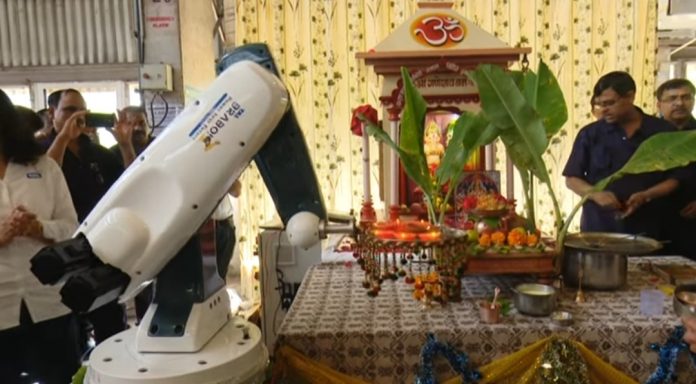By Allen S. Maller
In 2017, a technology firm in India introduced a robotic arm to perform “aarti,” a ritual in which a devotee offers an oil lamp to the deity to symbolize the removal of darkness. This particular robot was unveiled at the Ganpati festival, a yearly gathering of millions of people in which an icon of Ganesha, the elephant-headed god, is taken out in a procession and immersed in the Mula-Mutha river in Pune in central India.
That robotic aarti arm has inspired several prototypes, a few of which continue to regularly perform the ritual across India today, along with a variety of other religious robots throughout East Asia and South Asia.
Ritual automation, or at least the idea of robotic spiritual practice, isn’t new in South Asian religions. Historically, this has included anything from special pots that drip water continuously for bathing rituals that Hindus routinely perform for their deity icons, called abhisheka, to wind-powered Buddhist prayer wheels – the kinds often seen in yoga studios.
Thaneswar Sarmah, a Sanskrit scholar and literary critic, argues that the first Hindu robot appeared in the stories of King Manu, the first king of the human race in Hindu belief. Manu’s mother, Saranyu – herself the daughter of a great architect – built an animate statue to perfectly perform all of her household chores and ritual obligations.
Folklorist Adrienne Mayor remarks similarly that religious stories about mechanized icons from Hindu epics, such as the mechanical war chariots of the Hindu engineer god Visvakarman, are often viewed as the progenitors of religious robots today.
However, the recent use of AI and robotics in religious practice is leading to concerns among Hindus and Buddhists about the kind of future to which automation could lead. In some instances, the debate among Hindus is about whether automated religion promises the arrival of humanity into a bright, new, technological future or if it is simply evidence of the coming apocalypse.
In other cases, there are concerns that the proliferation of robots might lead to greater numbers of people leaving religious practice as temples begin to rely more on automation than on practitioners to care for their deities. Some of these concerns stem from the fact that many religions in South Asia and globally, have seen significant decreases in the number of young people willing to dedicate their lives to spiritual education and practice over the past few decades
But if the answer to the problem of fewer ritual specialists is more robots, people still question whether ritual automation will benefit them. They also question the concurrent use of robotic deities to embody and personify the divine, since these icons are programmed by people and therefore reflect the religious views of their engineers.
Yet Hindus and Buddhists have for thousands of years used carved statues of wood and stone or molten metal without worrying about the religious views of the artists or craftsmen who made them. Of course, robots can move, and many of them are very intelligent, so that makes them very different from Buddhist wind driven prayer wheels.
Scholars often note that these concerns tend to reflect one pervasive theme which is very strange to believers within the three Abrahamic religions; an underlying anxiety that somehow the robots are better at worshipping gods than humans are.
For Hindus and Buddhists, the rise of ritual automation is especially concerning because their traditions emphasize what religion scholars refer to as orthopraxy, where greater importance is placed on correct ritual and liturgical behavior than on specific religions beliefs or feelings of community loyalty.
In other words, perfecting what you do in terms of your religious practice is viewed as more necessary to spiritual advancement than what you personally feel, believe or experience through your own religious community.
This also means that automated rituals appear on a spectrum that progresses from human ritual fallibility to robotic ritual perfection. In short, the robot can do your religion better than you can because robots, unlike people, are incorruptible; although they do where-out, break down or get re-programed, and robots cannot gain the spiritual benefit of fasting.
So robots are attractive replacements for dwindling Hindus and Buddhists priesthoods; but from the Abrahamic religions point of view, since people use them because no one worries about the robot getting it wrong, that still is not right.
***
Allen S. Maller is an ordained Reform Rabbi who retired in 2006 after 39 years as Rabbi of Temple Akiba in Los Angeles, California. His web site is: www.rabbimaller.com. He blogs on the Times of Israel. Rabbi Maller has published 850+ articles in some two dozen different Christian, Jewish, and Muslim magazines and web sites. Over 150 of his articles are on islamicity.com and Eurasia Review.com. Rabbi Maller’s three recent books: “Judaism and Islam as Synergistic Monotheisms’; “Which Religion Is Right For You?”; and “Qur’an and Torah, Islam and Judaism” are available on Amazon.


